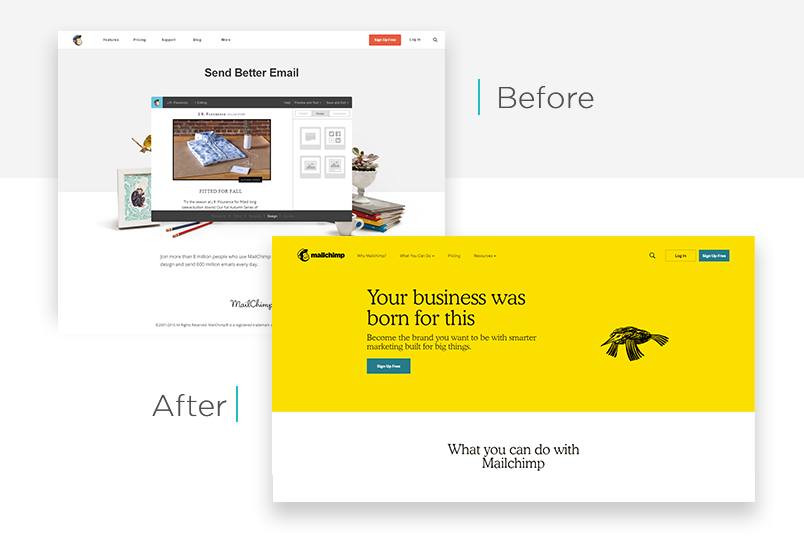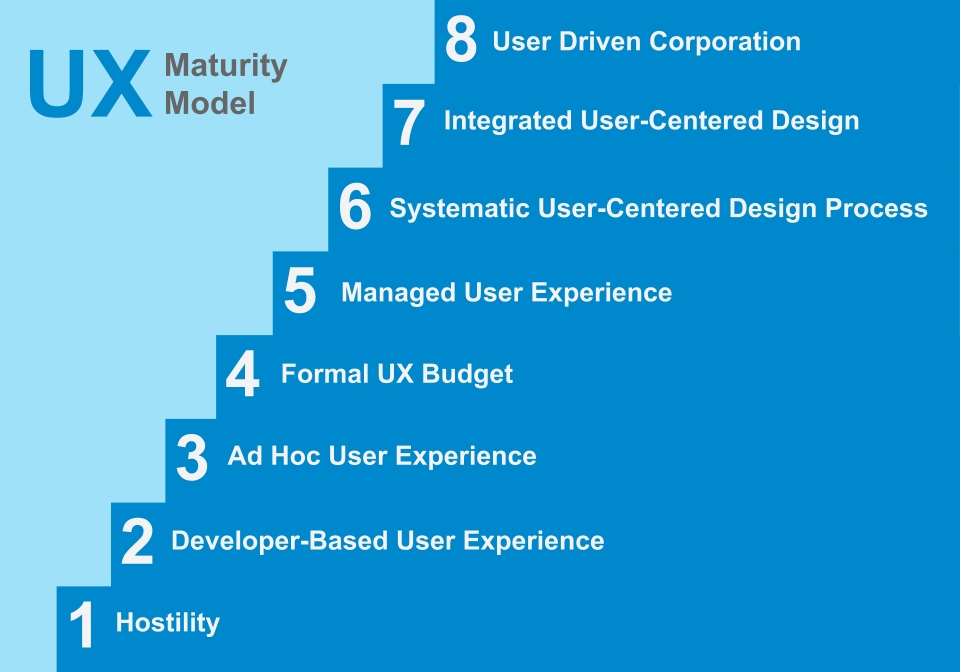Organizations usually progress through a series of stages following the evolution and maturity of their UX processes. The stages of Corporate UX Maturity are fairly universal, allowing the ability to match your organization to see what the next stage will likely be, and what needs to be done in order to progress to the next stage.
In this Article
We have been working with corporate clients who are in different stages of maturity and we found it helpful to identify with the clients which stage they are on, this helps with internal alignment, the next steps and resources planning.
Stage 1: Hostility
The initial stage starts with hostility: developers, business stakeholders and working teams don’t want to hear about the users and their needs, their main goal is to develop features that work.
With this mindset, users are irrelevant and are instructed how to use the system instead of having the system designed for user experience. Taking history into perspective, back in computing’s early days from 1945 to 1965, hardware was so expensive that the most cost-effective approach was to train people how to use the hardware.
As time grew on, after 1965, computers got cheaper and with enough people using computers, there was more economic return from reducing training costs and by increasing user productivity.
One of the indicative signs that your organisation is in this stage is when your organisation’s main response for hard-to-use software comments is by preparing a user manual or having large group training, all these points towards the user being the problem for not knowing how to use your software. If your company is still at this stage of hostility towards usability, it’s safe to say that user experience is the least of your company’s worries. People have to want to change before there’s any chance of actually changing.
Stage 2: Developer-Based User Experience
Most companies eventually come to realize the value in designing for humans. At this stage, the design team relies on its own intuition and goes with their assumptions on what good usability should look like.
Sure, the team members are indeed human beings that use computers and websites. Plus, they are already onboard and are involved in all the project meetings so they definitely have an opinion or two to share.
This approach works quite well, but only for one class for design problem: tool development, such as web server, for developers. Open-source projects like Apache, Linux and Perl have been successful with developer-based design. However, it is worth noting that these projects could be better with more systematic usability input from those outside the design team.
Now for projects that are for non-developers, it’s a disaster to rely on the design team’s understanding of ‘easy’. Anyone working on a project will definitely know much more, perhaps too much, to be able to represent proper target users. Thankfully, it’s easy to explain the difference between an average user and the team member’s conceptual model.
During this stage, there is a huge advantage in that people care about usability. However, this is just a start, you may even find that the high-level executives may be onboard and supportive but lack in action in terms of actually funding usability work.
So whilst it isn’t possible to go straight to an elaborate usability process from stage 2, people are at least receptive to UX and are willing to move to stage 3.
Stage 3: Ad Hoc User Experience
It’s at this stage that the organization understands that it shouldn’t rely on the design team’s judgement of user experience. However, most design decisions will continue relying on this judgement because people tend to assume that they are the focal point. So while the designers understand they should get external insights, they don’t actually try very hard to get it.
Despite the barriers, there is a small UX initiative taking place, maybe it’s running a simple test or even engaging a usability expert for an independent audit of the user experience. If you are interested in doing so, Netizen Experience has a team of trained user researchers and UX consultants.
There may not be recognition of user experience as an official discipline, nor is there an approved budget allocated to user experience. Where all UX efforts and user researcher are driven by user advocates and are done ad hoc to obtain data, in order to improve what they are working on.
However, ad hoc usability is effective, even the tiniest UX effort of testing with 2 users can make a difference. When designs have a small usability input, it gets better, hopefully so much so that the results speak for themselves.
The disadvantage is that really great user experience may seem so blatantly obvious that the management may not be able to recognize how much work is needed. In order to prevent being overlooked, create a side by side comparison for the before/after by saving the initial design ideas to document the advances in UX.

Credit: https://www.justinmind.com/blog/5-excellent-website-redesigns-before-and-after/
In this example above, we see that in the ‘before’: Mailchimp’s homepage was simple with a top menu navigation with a very clear value proposition displayed. ‘After’: Mailchimp’s homepage has been revamped using colour, has an even more simple and cleaner interface and the call-to-action (CTA) stands out much more compared to the ‘before’ version.
By having this side-by-side comparison of before and after, it helps to showcase and highlight all the UX advances, after all, a picture is worth a thousand words.
Stage 4: Formal UX Budget
The primary cause of a dedicated UX budget stems from the small efforts in ad hoc UX studies in stage 3 that has stirred the interest of the management, convincing them that there is profit to be made from improving user experience.
The biggest difference between this stage and stage 3 is an exclusive UX budget, however small. This means that UX activities are now part of the plan.
Depending on the size of the company, the UX budget may be a percentage of a single employee’s time or it may even allow for a handful of full-time UX specialists. There isn’t a systematic process in place yet, and the UX staff may be scattered around the company. But it’s a start.
In this stage, UX is mainly viewed by the company as a light polish to shine up the user interface. The main form of usability testing tends to be user testing which takes place late in the development cycle after the user interface is more or less implemented.
This is against best practices, where it’s recommended to do early and frequent testing, even using paper prototypes to test without having to do a full-scale design implementation.
It’s important to point out: the more work that goes into implementing the user interface, the less likely that management will be willing to make changes. These changes that are typically required after the design has been shown to real users.
Moving from stage 3 to stage 4 is fairly easy, there are credible results from the ad-hoc user experience activities, and it can be done affordably too. But to move up from stage 4, even more proof of ROI is required to make a point.
For a real budget, bigger improvements are needed to justify an increased UX investment. These improvements will come, but it takes time. And it takes more than a couple of success stories for justification, perhaps it needs to be shown in the form of higher conversion rates, better productivity, or whichever business measure that is applicable to your company. Properly implemented Digital Analytics can help with tracking the performance and increase in conversion, the analytics data can be strong evidence for justifying the ROI.
Make it a point to collect results and evidence across all the user experience projects, and build a strong case study for user experience to excel up to stage 5.
Stage 5: Managed User Experience
Moving through the first 4 stages can be quite fast, progressing through the remaining stages usually takes much longer.
At this stage, there’s a well-formed UX entity: an official UX group with a UX manager. The group may start with a few members, but tends to grow in size, along with acquiring a dedicated UX lab as the company invests more in user testing.
There is now a dedicated team with a leader whose sole responsibility is to elevate the user experience across the company and throughout design projects. UX managers shouldn’t try to fix all the individual design mistakes, their job is to ensure there is high design quality with good usability following a managed process.
Comparing to stage 4 where user research is done late in the development cycle, in stage 5, the studies are conducted more consistently throughout the cycle, but generally still focusing on user testing.
As the team members learn from each other, the group redefines its methodology and can also maintain a usability report database to compile findings and results. Doing this helps to improve the understanding of the company’s users, in turn, cultivating a company-specific design guideline.
These cross-study insights help to move towards the systematic usability process of stage 6. The UX manager must also create opportunities to showcase UX to senior management, in highlighting the business value that can be driven from a systematic approach as opposed to just running tests at the end of development.
Generally, at this stage, the UX budget is too tight to implement all the recommended usability methods for all the projects. Which is why the UX manager needs to be quite selective in choosing promising projects and ensuring that they become strong evidence for user-centered design.
Stage 6: Systematic User-Centered Design (UCD) Process
At this stage, the company recognizes the needs for a user-centered design process. This is where early user research is done before starting any design for important projects, and there is a user interface design standard or at least a centralized design pattern/guide.
There is also likely a place to track user experience quality throughout design projects, and across releases and updates. This allows the upper management to monitor these quality indicators as they would with other business indicators.
In addition, iterative design is more common in this stage as the company understands that the best interface quality can’t be achieved in just one round of usability fixes. That much better results stems from a gradual refining of designs – from early paper prototypes to the final implementation – testing them step by step.
The UX budget at this stage is large enough for projects to have sufficient resources for a range of user research, that even projects without much UX resources go through at least some form of design review before being approved for release.
Aside from iterative design, UX budget and monitoring user experience. Another sign of maturity at this stage is that projects are prioritized according to the business value of their user experience.
In order to progress beyond stage 6, all the stakeholders need to be convinced that user experience is an essential element of their jobs, and that user research results helps them create more satisfying work.
Stage 7: Integrated User-Centered Design
At stage 7, each development step goes hand-in-hand with user data, this includes the project definition itself and the requirements phase.
At stage 6 where it’s typical to estimate user experience quality, at stage 7, the company often tracks quality through quantitative usability metrics. So much so that each project has defined usability goals that must be achieved in order for it to be approved for release.
For the previous 6 stages of maturity, usability is a quality discipline that helps ensure ease of use. But at this stage, the company starts to make use of usability data to determine what needs to be built.
It’s often hard to move beyond stage 7, because stage 8 takes UX beyond design. In order to cross this bridge, there is a need to cycle back and focus again on educating senior executives.
Stage 8: User-Driven Corporation
At this final stage, user data doesn’t only define individual projects but it determines what projects the company should fund by making use of user research to determine overall priorities and direction.
Furthermore, user experience is extended beyond the screen to other forms of interaction, such as service design issues on how to design guest rooms and lobbies for hotels.
There is only one degree of difference between stage 7 and stage 8, where the company uses many of the same research methods but at this stage, the methods actually affect corporate strategy and activities beyond interface design.
It’s rare that companies use real behaviorally observed user data to make corporate decisions, instead most companies make do with surveys or other forms of less-valid indicators.

Moving up One Step at a Time
These are estimates of the time it typically takes for a company to move from one stage of UX maturity to the next:
- Stage 1: A company can remain hostile for a very long time, even decades, until a design disaster really hits the nail in order for the company to be encouraged to move ahead.
- Stages 2-4: It often takes 2-3 years in each of these stages, once a company enters stage 2, it could take about 7 years in total to reach stage 5.
- Stages 5-7: Progress in maturity in these stages are considerably slower, a company will often take 6-7 years each in stage 5 and 6, taking up to a total of 13 years to move from stage 5 to stage 7.
- Stage 8: Very few companies reach the highest level of usability maturity, it most case, it takes about 20 years.
The exact timing differs among companies, but the critical constant is progressing through these levels in sequence. Some start-ups may get lucky and can start the maturity process at stage 3, or even stage 4. But like other companies, they must progress through the upper levels in sequence.
It may be tempting to move directly to one of the higher levels, but too much simultaneous changes won’t allow people the time to adjust and cope with the concepts and requirements of the later stages, resulting in quite a disaster. To get to a higher level, don’t skip a step. Instead, jump from one stage to the next quickly.

